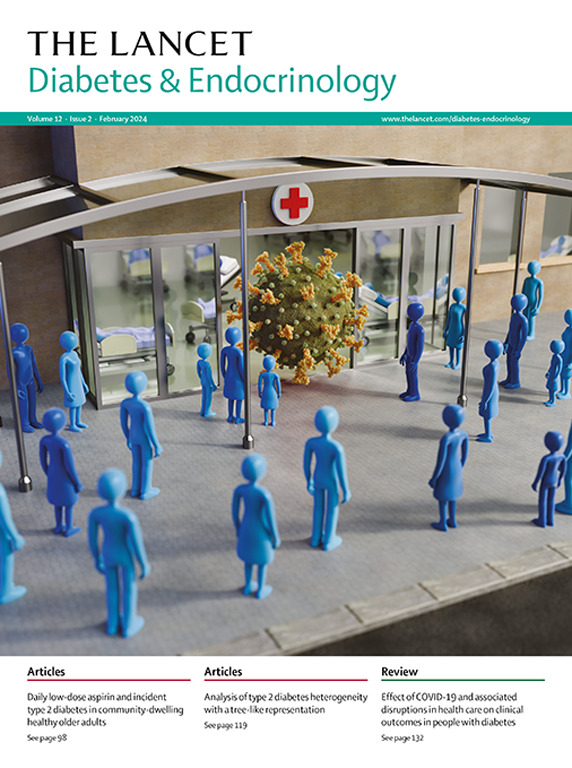Roux-en-Y gastric bypass, adjustable gastric banding, or sleeve gastrectomy for severe obesity (By-Band-Sleeve): a multicentre, open label, three-group, randomised controlled trial
IF 44
1区 医学
Q1 ENDOCRINOLOGY & METABOLISM
引用次数: 0
Abstract
Background
The health risks of severe obesity can be reduced with metabolic and bariatric surgery, but it is uncertain which operation is most effective or cost-effective. We aimed to compare Roux-en-Y gastric bypass, adjustable gastric banding, and sleeve gastrectomy in patients with severe obesity.Methods
By-Band-Sleeve is a pragmatic, multi-centre, open-label, randomised controlled trial conducted in 12 hospitals in the UK. Eligible participants were adults (aged ≥18 years) meeting national criteria for metabolic and bariatric surgery. Initially, a 2-group trial (Roux-en-Y gastric bypass versus adjustable gastric banding) became a 3-group trial to include sleeve gastrectomy at 2·6 years from study opening, when it became widely used in the UK. Co-primary endpoints were weight (proportion achieving ≥50% excess weight loss) and quality-of-life (EQ-5D utility score) at 3 years. If the proportion achieving at least 50% excess weight loss was non-inferior (<12% difference between groups) and quality-of-life was superior, sleeve gastrectomy and Roux-en-Y gastric bypass were considered more effective than adjustable gastric banding, and sleeve gastrectomy more effective than Roux-en-Y gastric bypass. Cost-effectiveness of the procedures was compared. This trial is registered with ClinicalTrials.gov, NCT02841527, and ISRCTN, 00786323.Results
Between Jan 16, 2013, and Sept 27, 2019, 1351 participants were randomly assigned; five withdrew consent and 1346 (mean age 47·3 [SD 10·6] years, 1020 [76%] women, 324 (24%) men, and two with missing data, mean weight of 129·7 kg [23·6] and mean BMI of 46·4 [6·9] kg/m2) were included in this report. Of 1346 participants, 462 (34%) were in the Roux-en-Y gastric bypass group, 464 (34%) in the adjustable gastric banding group, and 420 (31%) in the sleeve gastrectomy group. 1183 (88%) participants underwent surgery. 276 (68%) of 405 participants in the Roux-en-Y gastric bypass group, 97 (25%) of 383 participants in the adjustable gastric banding group and 141 (41%) of 342 participants in the sleeve gastrectomy group achieved at least 50% excess weight loss (adjusted risk difference: Roux-en-Y gastric bypass vs adjustable gastric banding 41% [98% CI 34 to 48]; sleeve gastrectomy vs adjustable gastric banding 15% [5 to 24]; sleeve gastrectomy vs Roux-en-Y gastric bypass, –26% [–36 to –16%]). Mean EQ-5D scores were 0·72 for Roux-en-Y gastric bypass, 0·62 for adjustable gastric banding, and 0·68 for sleeve gastrectomy (adjusted mean difference: Roux-en-Y gastric bypass vs adjustable gastric banding 0·08 [0·04 to 0·12], sleeve gastrectomy vs adjustable gastric banding 0·05 [0·01 to 0·09], and sleeve gastrectomy vs Roux-en-Y gastric bypass –0·03 [–0·07 to 0·01]). 1651 adverse events were reported following surgery (5·7 per year after sleeve gastrectomy, 6·0 per year after Roux-en-Y gastric bypass, and 4·6 per year after adjustable gastric banding). There were 11 deaths from randomisation to 3 years: one attributable to surgery (in the adjustable gastric bypass group, during the surgical admission) and ten not attributable to surgery (four each in the Roux-en-Y gastric bypass and adjustable gastric banding groups and two in the sleeve gastrectomy group). Roux-en-Y gastric bypass was most cost-effective.Interpretation
Roux-en-Y gastric bypass and sleeve gastrectomy are more effective than adjustable gastric banding. Sleeve gastrectomy has inferior weight loss and lower mean quality of life score compared with Roux-en-Y gastric bypass. Based on this evidence, it is recommended that patients electing to have metabolic and bariatric surgery are advised to have Roux-en-Y gastric bypass. Where contraindicated or unfeasible, sleeve gastrectomy should be offered. This evidence does not support adjustable gastric band as standard treatment for severe obesity.Funding
National Institute for Health and Care Research Health Technology Assessment Programme.求助全文
约1分钟内获得全文
求助全文
来源期刊

The Lancet Diabetes & Endocrinology
ENDOCRINOLOGY & METABOLISM-
CiteScore
61.50
自引率
1.60%
发文量
371
期刊介绍:
The Lancet Diabetes & Endocrinology, an independent journal with a global perspective and strong clinical focus, features original clinical research, expert reviews, news, and opinion pieces in each monthly issue. Covering topics like diabetes, obesity, nutrition, and more, the journal provides insights into clinical advances and practice-changing research worldwide. It welcomes original research advocating change or shedding light on clinical practice, as well as informative reviews on related topics, especially those with global health importance and relevance to low-income and middle-income countries. The journal publishes various content types, including Articles, Reviews, Comments, Correspondence, Health Policy, and Personal Views, along with Series and Commissions aiming to drive positive change in clinical practice and health policy in diabetes and endocrinology.
 求助内容:
求助内容: 应助结果提醒方式:
应助结果提醒方式:


